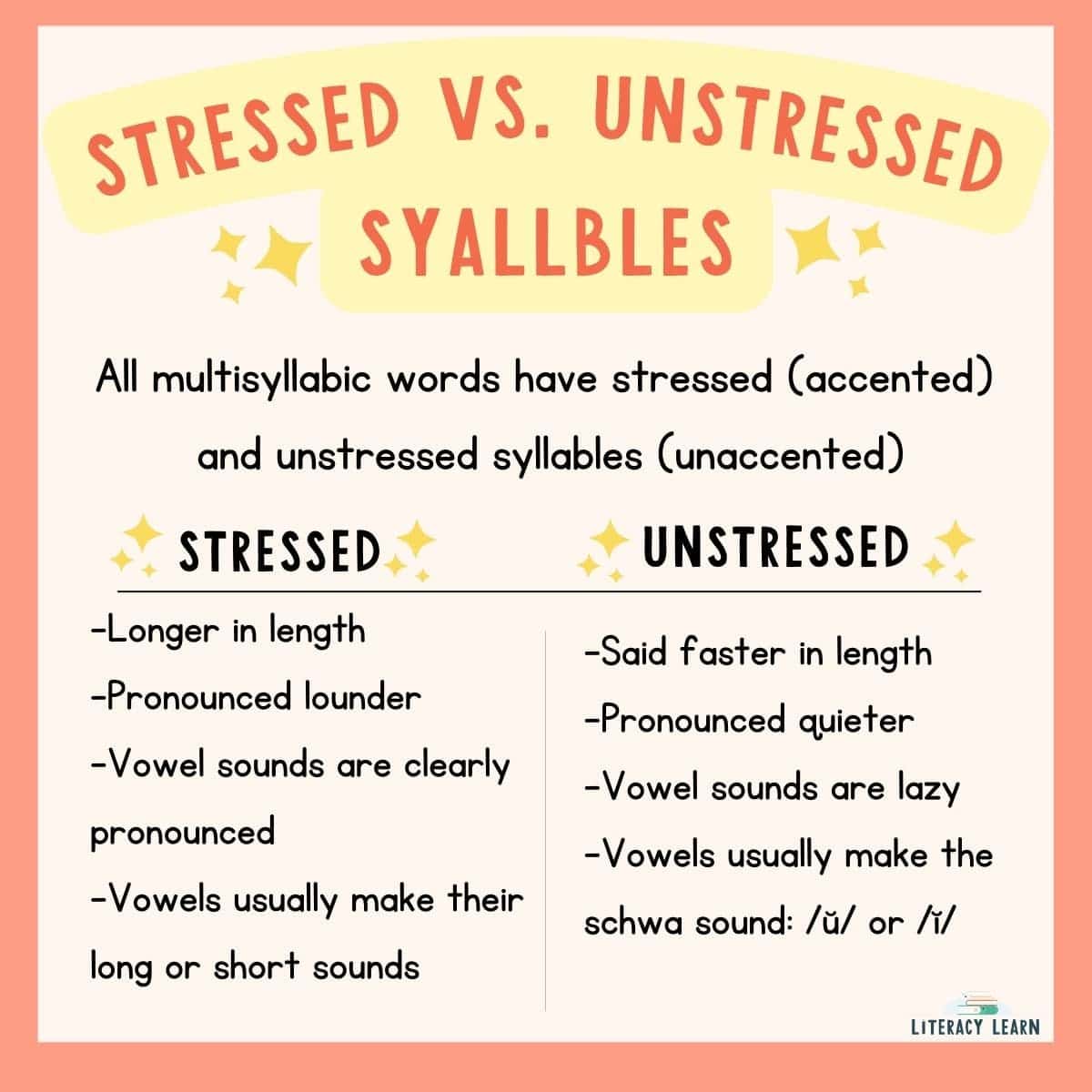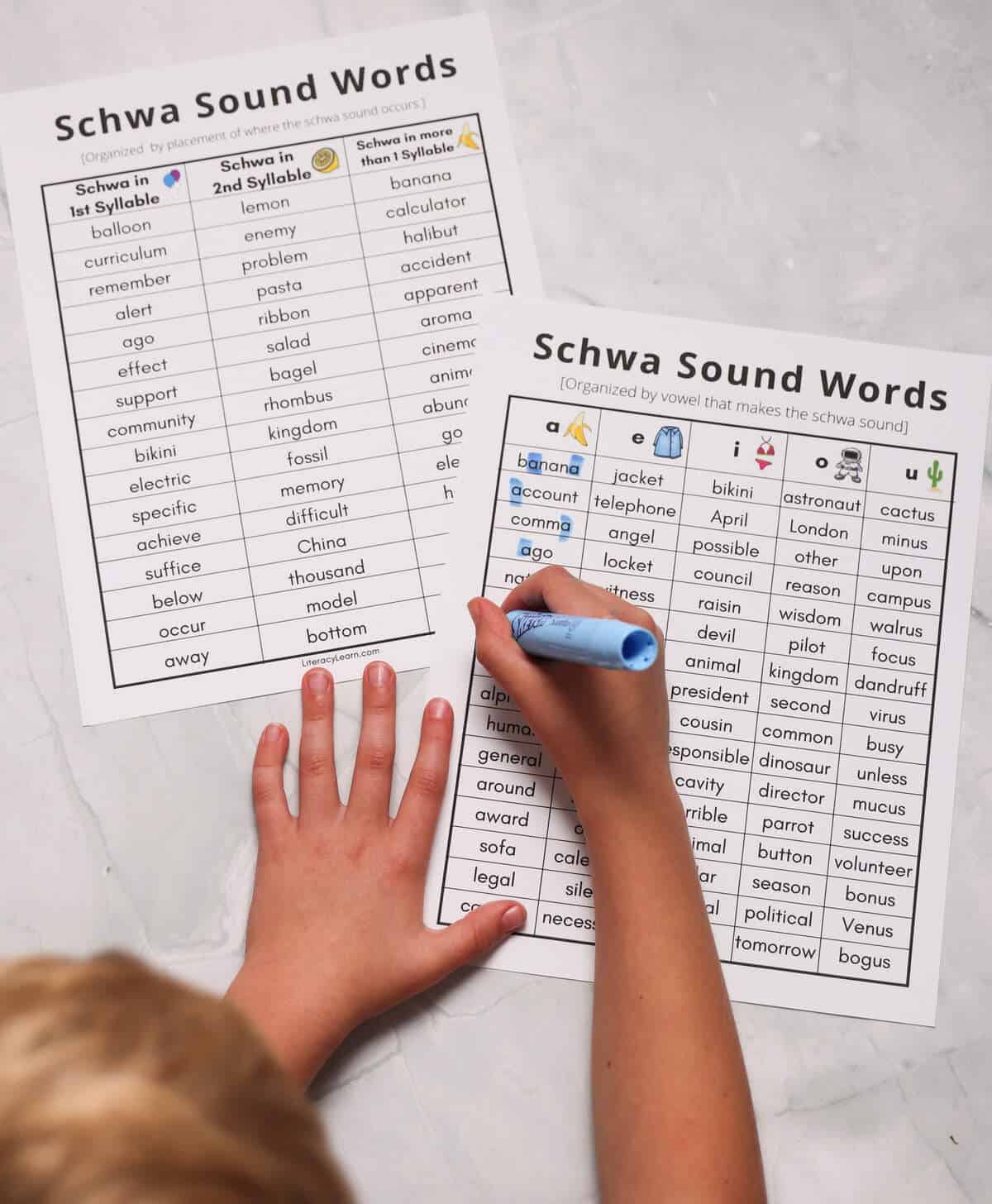The Schwa Sound: What It Is & How to Teach It
This post may contain affiliate links. As an Amazon affiliate, we earn from qualifying purchases.
Learn all about the most common vowel sound in all of English: the schwa sound. Then get practical tips and ideas for teaching the schwa vowel sound to your students for accurate reading and spelling.

Schwa Sound Fast Facts
👉 The schwa sound is the most common vowel sound in English.
👉 It’s the sound that’s heard in unstressed syllables and sounds a lot like a short /ŭ/ (‘uh’), or short /ĭ/ (‘ih’) sound. You can find it hiding in plain sight in words like “banana,” “octopus” and “balloon.”
👉 The schwa sound is essential in English because it helps maintain the rhythm and flow of spoken language.

👉 Schwa is sometimes referred to as a lazy vowel because the mouth hardly opens when saying it. And since it’s only found in unstressed syllables, you sometimes can hardly hear it.
👉 The schwa sound is found in multisyllabic words, and it can be spelled with any of the five vowels. It is also found in many function words, like the, and a.
👉 The schwa sound, or phoneme, is represented by an upside-down lowercase letter E that looks like this: /ə/. You will see the schwa symbol /ə/ on sound walls or in dictionaries for pronunciation of words.
Unstressed Syllables
In order to teach the concept of schwa to students, they need to understand stressed syllables (sometimes called accented syllables) and unstressed syllables (sometimes called unaccented syllables).

This is important because the schwa sound will only ever appear in unstressed syllables, so kids need to know the difference.
👉 Stressed (accented): The part of a multisyllabic word said with greater emphasis.
👉 Unstressed (unaccented): The part of a multisyllabic word said with less emphasis.
To help understand stressed vs. unstressed syllables, think of this expression, because it demonstrates stressed vs. unstressed syllables, along with words with schwas:
🎶“You’re putting the em-PHA-sis on the wrong syl-LA-ble.”
We don’t say the word ’emphasis’ or ‘syllable’ with stress on the middle syllable. It just sounds weird that way!
In both words, the first syllable is stressed – it’s said louder with greater emphasis. Then the second syllable is unstressed and includes a schwa.
In both words, the letter A in the second syllable is not making its long /ā/ or short /ă/ sound; instead, it makes the /uh/ sound because it is a schwa!
Another example is the word contract. This word can have different meanings based upon which syllable is stressed.
👉 If the emphasis is on the first syllable, the word is contract – a binding agreement: “I entered into a contract with my landlord.“
👉 If the emphasis is on the second syllable, the word is contract – to make smaller: “The doctor put eyedrops in to make my pupils contract.” Notice how in this word, the unstressed syllable, con, includes a schwa sound! The letter o says ‘uh’ in this syllable.
Generalizations
Guidelines for determining which syllables are stressed (accented):
- Base words are usually stressed, not prefixes or suffixes (hopping, review).
- If the base word has two syllables, the first syllable is usually stressed (atlas, basket, tonsil).
- If the word ends with a silent e and has more than 3 syllables, there is usually one syllable between the accepted syllable and the silent-e final syllable (confiscate, illustrate, adrenaline).
- One-syllable function words are usually unstressed.
Schwa Examples

These words include the schwa sound. The vowel that represents the schwa sound is underlined, making it easy for you to isolate the schwa sound in each word:
- image
- alphabet
- alligator
- wagon
- banana
- blossom
- eleven
- adopt
- bottom
- bonus
- telephone
- accident
- bacon
- bonnet
- ago
- soda
- gallon
- China
- token
- asleep
- freedom
- complain
- extra
- emblem

👆 Get 2 FREE printable Schwa Word lists with 128 words, organized by vowel or syllable.
How to Teach the Schwa Sound
Introducing the concept of the schwa sound can be a game-changer for students, helping them improve their pronunciation, fluency, and overall comprehension of spoken and written English.
It will help them understand why the vowel isn’t saying its short or long sound, making sense of the English language!
You should start teaching the schwa after students have learned to decode and encode two-syllable words (like rabbit words).
🗣️ Start with Listening Exercises
- Begin by exposing your students to the schwa sound through listening exercises.
- Call out words with the schwa sound and have students identify the unstressed syllables with a schwa sound.
📖 Decode Words with Schwa Sound
- As you teach students rules for syllable division, you will introduce them to decoding words with schwa sounds.
- I like to teach kids this procedure: “1. Try it Short, 2. Try it Long, 3. Try It Schwa.” Reading experts call this set for variability.
- This also helps to clarify that many words with schwa sounds are not rule breakers, but instead, follow spelling rules and reading rules consistent with the English language.
📜 Sort Patterns
- Teach kids these patterns in words to help them identify the schwa sound more easily.
- The schwa is often found at the beginning of words starting with the letter a (ago, across, adopt), and the end of words ending in the letter a (soda, sofa, banana).
- The schwa is often heard in the last syllable before the letter L or N (bagel, coral, wagon, bacon).
- Sorting practice is great for this. Kids can sort by where they hear the schwa (first, second or third syllable) OR sort by the vowel (a, e, i, o, u) that makes the schwa sound.

👀 Visualizing the Schwa Sound
- Just as we do with syllable division, marking words can be a great visual way to see patterns in words help kids to remember the sound the vowel will say.
- Children can mark the syllables and place the schwa symbol (ə) above the vowel that is a schwa. Using letter tiles is a great way to do this and incorporate multimodal practice.
🎯 Word Games
- Turn learning into a fun activity by playing word games that focus on the schwa sound. Create flashcards with words containing the schwa sound and have students practice reading them aloud.
- You can also play games like Bingo, where students mark words with the schwa sound on their cards.
📔 Literature Connections
- Incorporate schwa-rich texts into your reading sessions.
- Choosing decodable books that have many words with the schwa sound helps kids practice decoding and accurate pronunciation.
- Some great read-aloud book choices might be The Schwa was Here, The Umbrella, The Bagel King and My Hair is a Garden. During the reading, pause and ask students to identify words with schwa sounds.

🔠 Explicit Spelling Practice
- When teaching spelling with schwa words, teach a different pronunciation of the words (for spelling purposes only).
- For example, for the word ‘gallon’ you say the unaccented syllable with the schwa with the actual short or long vowel sound: “gal-LON.”
- Students can have practice this using our free schwa worksheets.
🔗 Build Word Connections
- Morphology is so important here. Knowing Greek and Latin bases will help kids make connections between words and ultimately help with spelling.
- 🐙For example: think about trying to spell the word: octopus. If students know that the Greek base is oct(o), it will help them know to spell the schwa sound with the letter O. Making connections between other words with that base with a different pronunciation is also helpful, like in the word October. Here you clearly hear the O!
- Research-based word analysis procedures, like using word sums, are an effective strategy for spelling words with schwa.
📺 Video
- This amazing “Lazy Schwa” video perfectly depicts the schwa sound for kids in a fun, engaging, and musical way!

📝 Dictation
- Use word dictation to practice spelling multisyllabic words with similar schwa patterns (e.g. words with the letter a that say /uh/.)
- You can also use sentence dictation with 1-2 words that include a schwa sound.
- When this is done, have your students read the words and sentences a few times to build automaticity.
- Get two FREE Schwa Word Lists here!
🔤 Use Dictionaries and Spell-Check Technology
- This is especially for children with learning disabilities, like dyslexia, who may need 40-200 exposures before it becomes a sight word.
- Allow kids to use this excellent technology to help assist them with accurate spelling.

Conclusion
Teaching the schwa sound might seem like a difficult concept, but as long as it is explicitly taught and kids have repeated exposure and practice, it can become an engaging and effective part of ‘cracking the code.’
Learning the schwa can help your students not make sense of why certain words sound or are spelled the way they are, but it will also improve their overall pronunciation, fluency, decoding, and encoding skills.
🧑🏾🏫 Fun Fact – Did you know that “Schwa” is a vowel symbol in Hebrew? When my husband was in graduate school, he studied Hebrew. So he chimed in and shared that it’s a symbol, more specifically, a vowel symbol, that presents the ‘uh’ sound in the Hebrew language!
Related Posts
- All About Long E Words + Free Printable List (233 words)
- All About Long I Words + Free Printable List (173 words)
- All About Long O Words + Free Printable List (131 words)
- All About Long U Words + Free Printable List (215 words)
Do you have questions or comments? We’d love to hear your best ideas for teaching the schwa sound or questions you still have. Please leave us a comment below.


Hi, I have a question about the word “victim”. Does “victim” take the final syllable “tim” /ĭ/ or /ŭ/ sound? Is this where the schwa fall?
Thanks!
Hi Kim,
Great question! This will depend on your dialect and where you’re teaching.
The second syllable in the word ‘victim’ is unstressed, meaning it COULD take on a schwa sound. Dictionary.com has the vowel letter I making its short sound /i/ and phonetically it’s pronounced: [ vik-tim ]. In this case, the vowel just keeps its short sound and isn’t technically a schwa.
But here’s where it gets tricky. When I say the word, I say it with the short /u/ sound in the second syllable [ vik-tum ] (I’m from Long Island) So when I teach it, I would definitely point out that it’s a schwa. But it really would depend on dialect. Hope that helps!
Katie
As a non-teacher who needs help teaching my son some reading skills, I love this page! Thanks for explaining it so clearly and providing examples.
Hi Hannah!
That’s awesome! Hopefully the information helps you understand the concepts, too. We’re so glad you found this information helpful.
Kate and Laura
This is the most comprehensive, excellent information for teaching schwa!
I didn’t know that the schwa sound could be short /u/ or short /i/. Has it always been this way?
Hi Dawn,
We’re so glad you found the information in the post helpful! It is important that we teach kids these explicit concepts so they don’t assume the English language is too hard to crack! We like to use the Ngram tracker to see when terms were introduced: It looks as though the term ‘schwa’ was first used in 1928. Hope that’s helpful!
Katie and Laura
I have a question, I’m a preschool/ Pre-K teacher. I was told by my administration, that I teach my students the wrong sounds. I put the schwa in the sounds. They want me to not use the schwa sound anymore. I’m trying to learn not to do this. I guess my question is what age do students need to learn the schwa sounds?
Hi Richele,
I think your admin may mean you’re adding some extra sounds to the end of the actual sounds. For example, some people might say P says /puh/. Instead, try clipping the sounds to not add the /uh/ sound at the end. P says /p/ (like a little burst of air coming through your lips). I would not teach kids pre-k kids about schwa. They need to master the most common and most frequent sound first. Also, be sure you don’t teach soft sounds yet – G says /j/ like giraffe or C says /s/ like cent. Most scope and sequences teach soft sounds and schwa in second grade. I hope this helps!
Katie and Laura